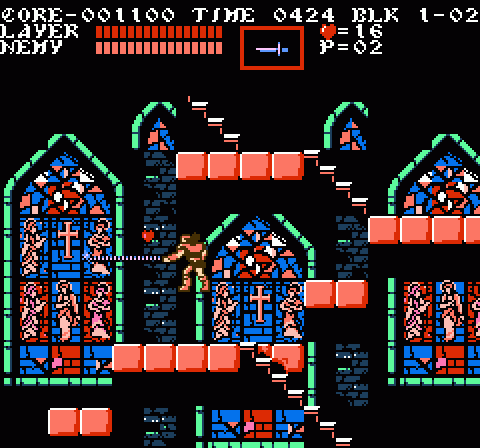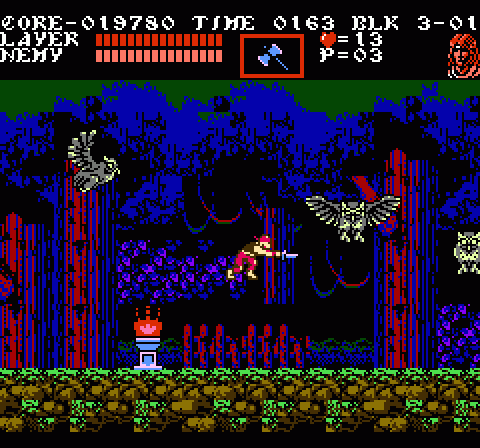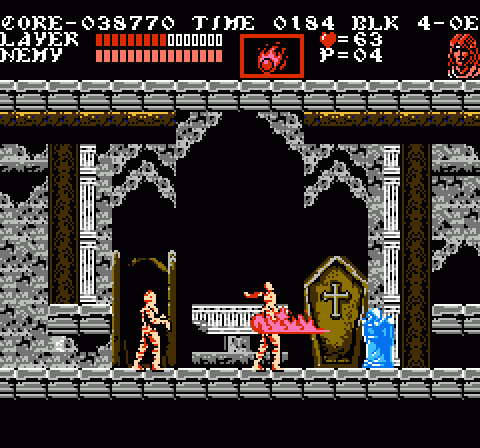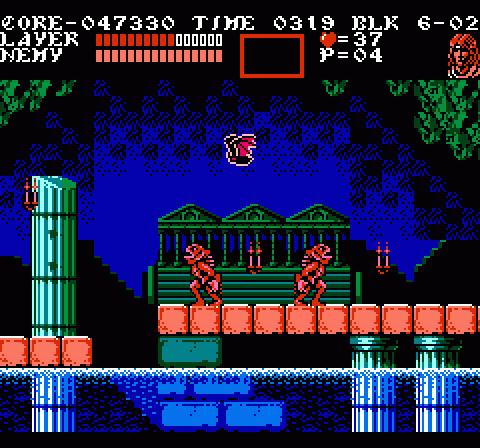Now that we’ve collected the whole Pokémon assortment of companion characters in Dracula’s Curse, we can take a moment to look at them — compare strengths, weaknesses, flaws, that sort of thing. Some of have more or one or the other than the rest.
Trevor Belmont: Not surprisingly, Trevor is ultimately the best and best-rounded character in the game. You’ll find few situations where he can’t at least hold his own, even if one of this allies might have a specific advantage. Trevor ties with Alucard for having the best endurance (by the end of the game, they lose 25% of their health meter per hit). The upgraded Vampire Killer whip is the second strongest attack available (and unlike the other is free to use). He possesses the broadest skill set, capable of wielding more subweapons than any other character.
Trevor represents the baseline against which the entire world design has been developed. His skills — his speed, range, arsenal, and weaknesses — determine the way every level works. The height of objects, the space of gaps, the length of staircases, and the frequency and patterns of foes all contrast Trevor’s ability to handle them. If Castlevania III is a jazz standard, Trevor provides the steady beat against which the other characters allow you to improvise.
Grant Danasty: Grant sacrifices Trevor’s durability, power, range, and versatility for agility. He’s the only character in the entire NES Castlevania trilogy who can alter the trajectory of his jump in mid-air. He jumps higher than Trevor, and since he stoops as he walks he can fit into smaller places. More importantly, though, he can stick to walls and ceilings. This allows him to access areas that no other character can — most significantly little alcoves specifically designed for Grant to climb to and collect a 1UP.
Downsides? Well, Grant is super-weak; his dagger has no range to speak of and is only as strong as Trevor’s default whip. It can’t be upgraded. In the Japanese version, Grant threw his dagger with each strike, but this feature was removed for the U.S. version. This had the effect of greatly reducing Grant’s moment-to-moment usefulness and presumably resulted from one of those weird re-balancing Japanese developers made to fight the deadly threat of rentals by making the American versions of their games impossible to beat in a weekend.
In Japan, Grant could only use the Axe subweapon, whereas he can also collect the Dagger in the U.S. This doesn’t work nearly as well as having the Dagger as a default skill, since it forces players to swap equipment in order to attack straight ahead or at an angle and means that you have to do the up + attack move to throw a knife.
So, while he’s not much for combat, Grant comes in handy as a means to maneuver players into battle safely, delivering Trevor into the thick of things with minimal damage.
Sypha Belnades: Sypha represents the opposite tradeoff to Grant. She, like him, is much physically weaker than Trevor, with a physical attack that lacks range and strength, and she takes more damage per hit. But where Grant makes up for it with speed, Sypha makes up for it with raw combat power. Sure, her staff attack sucks, but that’s not why you use Sypha. She’s all about magic.
Sypha knows three spells (and can tragically use the Stopwatch, which remains as rarely useful here as ever), each of which is incredibly useful. I’ve detailed them already, but to summarize: Fire has the range of the top-level Vampire Killer but is twice as strong; ice can completely immobilize any non-boss foe and render it destructible with a single blow; and lightning sends three enemy-seeking balls of energy into play, allowing you to focus on evasion against tough foes and not have to worry about aiming or tactics.
Basically, Sypha is kind of insanely overpowered.
Adrian “Alucard” Fahrenheit Tepes: The son of Dracula is surprisingly your weakest ally. He can’t use subweapons (save the stupid Stopwatch), his fireballs are the weakest attack in the entire game, and his one power — while versatile! — comes with a severe caveat. Alucard can transform into a bat and fly freely about the screen, but if anything strikes him he reverts to human form and plummets like a rock. So you really don’t want to bump into something while you’re bypassing, say, a pit. While his base attack has great range, it’s slow and weak and has very situational applications. And his alternate form is completely without offensive capabilities, making Alucard even more a character focused around evasion than Grant. No wonder he switched to swordplay for Symphony of the Night.
What’s great about Dracula’s Curse is that all the characters are viable for the entire game — some more so than others, and certain areas are better suited to a specific skill set, but you can play through the quest and all its different courses with every permutation of characters and have a great time.




I’m still amazed at how weak Alucard is in the grand scheme of things. I was then, and I remain so now. And then he gets chosen to star in SotN… I guess that was apparently for who he was, since it clearly had nothing to do with how he played here.
I remember being disappointed initially that you couldn’t swap out Trevor, and have, say, a Grant/Sypha team (though that may be for the best). Or, as I stated in an earlier entry, assemble a full team of four, TMNT-style as earlier previews had led me to believe.
Seconding the disbelief at how bad Alucard is at practically everything, considering the god-being he becomes in Symphony. A fully equipped and powered-up Alucard could tear the universe asunder. We’re all lucky he never took up his dad’s offer to be Dark Lord.
Having messed around a bit with each of the characters via name cheats and passwords, I definitely feel Alucard gets the most screwed. His default/only attack has the best range, but Grant and Sypha both hit harder and faster than him with their crappy default whip caliber weapons. Some airborne foes that a projectile spread would’ve been handy against take multiple hits for Al to kill; he can’t off a Medusa Head to save his life unless he has one upgrade to hit it with two fireballs. He can’t even attack when he’s on a staircase like everyone else can.
But that bat transformation can be pretty handy sometimes, despite the “turns back and falls if hit” handicap. While his melee options suck, as long as he has the hearts he can transform whether he’s on the ground or in the air or on a staircase. The final stage in particular has some bits where Al gets a chance to shine if you get there with him.
Series director (from Symphony on) Igarashi has said Dracula’s Curse is his favorite game in the series. I tend to think he generally went with Alucard and could never quite get Grant’s controls down, going by the relative importance the 3 characters have in the greater series.
Last time I played Dracula’s Curse I was delighted to learn that Alucard can return to bat-form if you use his special quickly during a long-fall.
Saved my ass during the first castle stage on the low route. Also a fun way to show off!